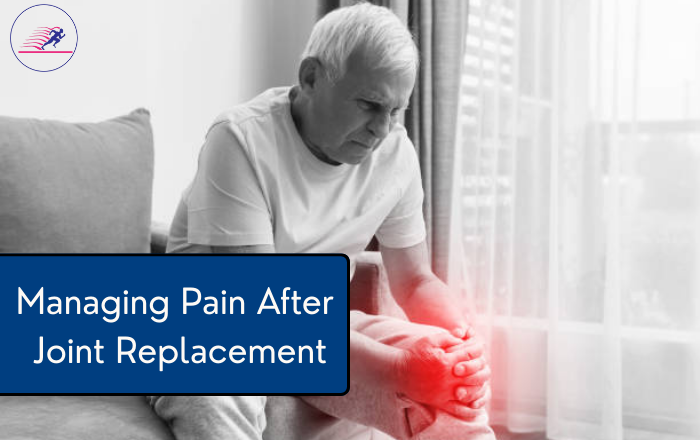Joint replacement surgery can be life-changing. Whether it’s your knee, hip, or shoulder, many people feel nervous about the pain that follows. The good news? With the right steps, you can manage that pain and get back to doing the things you enjoy.
In this blog, we’ll walk you through practical ways to manage pain after joint replacement surgery. You’ll also learn what to expect during recovery and when to reach out for help. If you’re recovering or planning surgery soon, this article is for you.
Why You Feel Pain After Joint Replacement Surgery
After surgery, your body begins the healing process. Pain is a natural part of that healing. It happens because:
- Your body has been through a major procedure.
- There’s swelling and inflammation around the joint.
- Muscles and tissues around the joint need time to adjust.
It’s also important to know the difference between normal pain and pain that needs medical attention. A little soreness, tightness, or swelling is common. But sharp, increasing pain or fever may be a sign of a problem.
Ways to Manage Pain After Joint Replacement Surgery
1. Take Your Medicine as Prescribed
Doctors often prescribe medications to help with pain. These may include:
- Over-the-counter painkillers like paracetamol or ibuprofen.
- Stronger medications, like opioids, for short-term use.
- Anti-inflammatory tablets to reduce swelling.
Always take medicine only as directed. Never skip doses, and don’t take more than recommended. If you feel uncomfortable or sleepy, let your doctor know. They may adjust your dose.
2. Use Ice Packs and Elevate the Joint
Cold therapy is a simple but powerful way to ease pain.
- Use an ice pack or a bag of frozen peas wrapped in a cloth.
- Apply it to the joint for 15–20 minutes at a time.
- Do this 3–4 times a day, especially in the first week.
Also, keep your leg or arm raised on a pillow while resting. This reduces swelling and helps blood flow.
3. Start Gentle Movement with Physical Therapy
It may sound surprising, but resting too much can make pain worse. Gentle movement:
- Keeps the joint flexible.
- Prevents stiffness.
- Speeds up healing.
Your physiotherapist will guide you with simple stretches and movements. These exercises help your joint get stronger, bit by bit.
Even walking around the house for a few minutes each hour can make a big difference.
4. Eat Foods That Help Your Body Heal
What you eat matters. Good nutrition supports recovery and helps control pain. Try to:
- Drink plenty of water.
- Eat fruits and vegetables rich in vitamins (like oranges, spinach, and carrots).
- Add proteins like eggs, lentils, or chicken to help rebuild tissue.
Avoid processed foods, sugary snacks, and too much salt—they can increase swelling.
5. Try Relaxation Techniques to Reduce Discomfort
Pain isn’t just physical—it’s also emotional. Stress and anxiety can make you feel worse. Try these simple techniques:
- Take slow, deep breaths when you feel tense.
- Listen to calming music or guided meditation.
- Get enough sleep, even if it means taking short naps during the day.
Staying calm and positive can make recovery feel less overwhelming.
What to Avoid During Recovery
While healing, some actions can slow progress or increase pain. Try to avoid:
- Skipping your exercises or therapy sessions.
- Sitting or lying in one position for too long.
- Taking more pain medicine than advised.
- Doing heavy lifting or bending the joint too far.
Listen to your body. If something doesn’t feel right, don’t force it.
When to Talk to Your Doctor
Some pain is normal, but if you experience any of the following, contact your doctor right away:
- Pain that suddenly gets worse.
- Redness or warmth around the joint.
- Pus or discharge from the wound.
- Fever or chills.
- Difficulty moving the joint at all.
Don’t wait—early care can prevent bigger issues later.
Tips from Dr. Rajeev Gawhale – Joint Replacement Surgeon in Phursungi
Dr. Rajeev Gawhale has helped many people recover from joint replacement surgery. His approach focuses on steady recovery, safe pain control, and keeping the patient active and informed throughout the journey.
At Bone & Joint Care Clinic in Phursungi, Dr. Gawhale offers support from day one of surgery through every step of healing. His patients often report smoother recovery thanks to clear guidance and well-planned follow-up care.
FAQs
1. How long does pain last after joint replacement surgery?
Pain usually improves after 2–3 weeks. Most people feel a lot better within 2–3 months. Full recovery can take 6 months or more.
2. What can I do at home to relieve pain after joint surgery?”
You can use ice packs, keep the joint raised, take your medicine on time, and do simple movements or stretches as advised by your doctor. Eating healthy and getting good rest also help with healing.
3. What foods help reduce pain and swelling after joint replacement?”
Foods rich in vitamins and anti-inflammatory nutrients help—like fruits, vegetables, whole grains, lean proteins, and healthy fats such as nuts and olive oil. Drink plenty of water too.
You Can Manage Pain and Heal Stronger
Pain after joint replacement is normal, but it doesn’t have to control your life. With the right care, daily movement, and a little patience, you can recover and feel better each week.
If you or a loved one is preparing for surgery or facing recovery challenges, consider talking to Dr. Rajeev Gawhale at Bone & Joint Care Clinic in Phursungi. He’s helped many people like you return to walking, moving, and living with comfort again.






